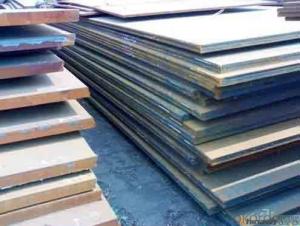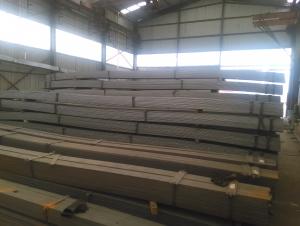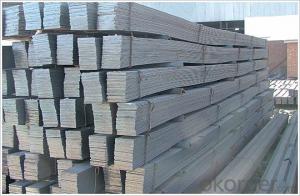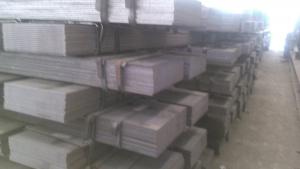Steel Pieces Slit From Steel Plate Sheet with Small Width
- Loading Port:
- China main port
- Payment Terms:
- TT or LC
- Min Order Qty:
- 25 m.t.
- Supply Capability:
- 10000 m.t./month
OKorder Service Pledge
OKorder Financial Service
You Might Also Like
1. Structure of Steel Pieces Slit From Steel Plate Sheet with Small Width Description:
Steel pieces slit from steel plate sheet with small width is a beam with an I-shaped cross-section. The horizontal elements of the "I" are known as flanges, while the vertical element is termed the "web". Steel pieces slit from steel plate sheet with small width is usually made of structural steel and is used in construction and civil engineering. The steel pieces slit from steel plate sheet with small width resists shear forces, while the flanges resist most of the bending moment experienced by the beam. Steel pieces slit from steel plate sheet with small width theory shows that the I-shaped section is a very efficient form for carrying both bending and shears loads in the plane of the web.
2. Main Features of Steel Pieces Slit From Steel Plate Sheet with Small Width:
• Grade: Q235
• Type: Mild carbon steel
• Deflection: The stiffness of the I-beam will be chosen to minimize deformation
• Vibration: The stiffness and mass are chosen to prevent unacceptable vibrations, particularly in settings sensitive to vibrations, such as offices and libraries.
• Local yield: Caused by concentrated loads, such as at the beam's point of support.
3. Steel Pieces Slit From Steel Plate Sheet with Small Width Images:
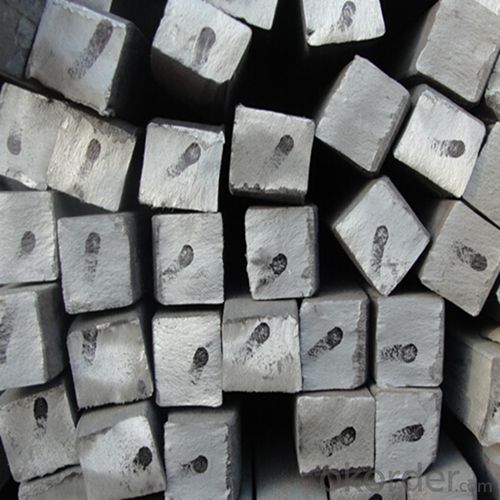


4. Steel Pieces Slit From Steel Plate Sheet with Small Width Specification:
Alloy No | Grade | Element(%) | ||||
C
| Mn
| S
| P
| Si
| ||
Q235
|
B
|
0.12—0.20 |
0.3—0.7 |
≤0.045 |
≤0.045
|
≤0.3
|
Alloy No | Grade | Yielding strength point(Mpa) | Tensile strength (Mpa) | Elongation after fracture(%) | ||||||
Thickness (mm) | Thickness (mm) | |||||||||
≤16 | >16--40 | >40--60 | >60--100 | ≤16 | >16--40 | >40--60 | >60--100 | |||
≥ | ≥ | |||||||||
Q235 |
B |
235 |
225 |
215 |
205 |
375--500 |
26 |
25 |
24 |
23 |
5. FAQ
We have organized several common questions for our clients,may help you sincerely:
①Is this product same as W beam?
In the United States, the most commonly mentioned I-beam is the wide-flange (W) shape. These beams have flanges in which the planes are nearly parallel. Other I-beams include American Standard (designated S) shapes, in which flange surfaces are not parallel, and H-piles (designated HP), which are typically used as pile foundations. Wide-flange shapes are available in grade ASTM A992,[4] which has generally replaced the older ASTM grades A572 and A36.
②How to inspect the quality?
We have a professional inspection group which belongs to our company. We resolutely put an end to unqualified products flowing into the market. At the same time, we will provide necessary follow-up service assurance.
③Is there any advantage about this kind of product?
Steel I beam bar IPE has a reduced capacity in the transverse direction, and is also inefficient in carrying torsion, for which hollow structural sections are often preferred.
- Q:Can steel flat bars be used for making automotive frames or chassis?
- Yes, steel flat bars can be used for making automotive frames or chassis. Steel is a popular choice for automotive frames and chassis due to its high strength and durability. Steel flat bars, which have a flat rectangular shape, can be used as structural components in the construction of automotive frames and chassis. They can be welded or bolted together to form the desired shape and size, providing excellent load-bearing capabilities and stability. Steel flat bars also have good resistance to impact and fatigue, making them suitable for withstanding various driving conditions and stresses. Additionally, steel is readily available and cost-effective, making it a practical choice for automotive manufacturers.
- Q:How are steel flat bars measured?
- Steel flat bars are typically measured by their width and thickness. The width refers to the horizontal dimension of the bar, while the thickness refers to the vertical dimension. Both measurements are usually expressed in millimeters or inches. For example, a steel flat bar might be specified as 50 mm wide and 5 mm thick. These measurements help to determine the overall size and shape of the bar, allowing it to be accurately used in construction, manufacturing, or other applications.
- Q:Are steel flat bars available in different finishes?
- Yes, steel flat bars are available in different finishes. Steel can be finished in a variety of ways to achieve different appearances and properties. Some common finishes for steel flat bars include hot rolled, cold rolled, brushed, polished, and galvanized. Each finish has its own unique characteristics and is suitable for different applications. Hot rolled steel has a rough and scaly surface, while cold rolled steel has a smoother and more refined finish. Brushed steel has a textured appearance created by brushing the surface with fine abrasive material. Polished steel has a shiny and reflective finish achieved through polishing and buffing. Galvanized steel has a protective zinc coating applied to the surface, providing increased corrosion resistance. These various finishes allow for customization and versatility in using steel flat bars for different projects and applications.
- Q:Can steel flat bars be used for manufacturing machinery or equipment?
- Yes, steel flat bars can be used for manufacturing machinery or equipment. They are commonly used in construction, automotive, and manufacturing industries to create structural components, frames, supports, and various machine parts due to their strength, durability, and versatility.
- Q:Can lightning protection earthing steel bar be directly welded with thread steel?
- Flat, refers to the width 12-300mm, thickness 4-60mm, cross section is rectangular in shape and with a blunt edge of steel. Flat steel can be finished steel, or can be used as the blank of welded pipe and thin slab for laminated sheet rolling. Main application: flat steel is used as a material, used for making iron, tools and machinery parts, and used as frame structures and escalators for buildings.
- Q:Can steel flat bars be used for making brackets or supports for agricultural machinery?
- Indeed, brackets or supports for agricultural machinery can be fashioned using steel flat bars. Renowned for their robustness and endurance, steel flat bars are well-suited for demanding tasks within the agricultural sector. They can be effortlessly shaped or joined through welding to fabricate personalized brackets or supports capable of enduring the rigorous circumstances and substantial burdens frequently encountered in agricultural machinery. What's more, steel flat bars are conveniently obtainable in diverse dimensions, enabling adaptability in both design and application.
- Q:Are steel flat bars suitable for making brackets or supports for water treatment systems?
- Steel flat bars are indeed a suitable option for crafting brackets or supports in water treatment systems. Renowned for its robustness and endurance, steel is an exceptional choice for bolstering weighty machinery or constructions. Moreover, steel's resistance to corrosion is of paramount importance in water treatment systems, where encounters with moisture are frequent. The malleability of steel flat bars allows for effortless customization into diverse forms and dimensions, catering to specific necessities and granting stability and dependability to the overall system. Hence, the utilization of steel flat bars in the creation of brackets or supports guarantees enduring and robust reinforcement for the equipment involved in the treatment process.
- Q:How do steel flat bars perform in terms of fatigue resistance?
- Steel flat bars generally have good fatigue resistance due to their high strength and stiffness properties. They can withstand repeated loading and stress cycles without experiencing significant structural damage or failure. However, the specific fatigue performance of steel flat bars may vary depending on factors such as the steel grade, manufacturing process, surface finish, and design considerations.
- Q:How do you prevent warping or distortion of steel flat bars during heat treatment?
- To prevent warping or distortion of steel flat bars during heat treatment, there are several key measures that can be taken. 1. Proper selection of steel grade: It is crucial to choose a steel grade that is less prone to warping or distortion during heat treatment. Some steel grades have better dimensional stability, such as low alloy steels, which can help minimize these effects. 2. Uniform heating and cooling: Ensuring a uniform and controlled heating and cooling process is essential. This can be achieved through the use of proper heating equipment, such as industrial furnaces with well-distributed heat sources. It is important to avoid localized heating or cooling, as this can lead to uneven expansion or contraction, causing warping or distortion. 3. Preheating: Preheating the steel flat bars before heat treatment can help alleviate internal stresses and reduce the risk of warping. This can be done by gradually increasing the temperature to the desired level in a controlled manner. 4. Proper fixturing: The use of appropriate fixtures or jigs during heat treatment can help support the steel flat bars and minimize distortion. Fixtures should be designed to evenly distribute the load and prevent bending or twisting during the heating and cooling process. 5. Slow cooling: Rapid cooling can induce internal stresses, leading to warping or distortion. Therefore, it is recommended to cool the steel flat bars slowly after heat treatment. This can be achieved by placing them in an insulated container or furnace, or by using heat sinks to control the cooling rate. 6. Stress-relieving treatment: After heat treatment, a stress-relieving treatment can be applied to further reduce internal stresses. This involves heating the steel flat bars to a specific temperature and holding it for a certain period of time, followed by a controlled cooling process. Stress-relieving can help restore dimensional stability and minimize warping or distortion. By following these preventive measures, it is possible to minimize the warping or distortion of steel flat bars during heat treatment, ensuring that the desired properties are achieved while maintaining dimensional integrity.
1. Manufacturer Overview |
|
|---|---|
| Location | |
| Year Established | |
| Annual Output Value | |
| Main Markets | |
| Company Certifications | |
2. Manufacturer Certificates |
|
|---|---|
| a) Certification Name | |
| Range | |
| Reference | |
| Validity Period | |
3. Manufacturer Capability |
|
|---|---|
| a)Trade Capacity | |
| Nearest Port | |
| Export Percentage | |
| No.of Employees in Trade Department | |
| Language Spoken: | |
| b)Factory Information | |
| Factory Size: | |
| No. of Production Lines | |
| Contract Manufacturing | |
| Product Price Range | |
Send your message to us
Steel Pieces Slit From Steel Plate Sheet with Small Width
- Loading Port:
- China main port
- Payment Terms:
- TT or LC
- Min Order Qty:
- 25 m.t.
- Supply Capability:
- 10000 m.t./month
OKorder Service Pledge
OKorder Financial Service
Similar products
New products
Hot products
Related keywords
